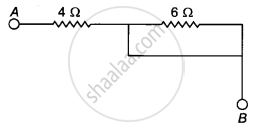Advertisements
Advertisements
Question
What is meant by the "resistance of a conductor" ? Write the relation between resistance, potential difference and current.
Solution
Resistance is the property of a conductor to resist the flow of charge through it. The relation between resistance, current and potential difference is V = IR.
APPEARS IN
RELATED QUESTIONS
A copper wire has diameter 0.5 mm and resistivity of 1.6 × 10−8Ω m. What will be the length of this wire to make its resistance 10 Ω? How much does the resistance change if the diameter is doubled?
What is the general name of the substances having infinitely high electrical resistance?
Distinguish between good conductors, resistors and insulators. Name two good conductors, two resistance and two insulators.
What happens to the resistance as the conductor is made thinner?
What will be the resistance of a metal wire of length 2 metres and area of cross-section 1.55 × 10−6 m2 if the resistivity of the metal be 2.8 × 10−8 Ω m?
Resistance of a metal wire of length 5 m is 100 Ω . If the area of cross - section of the wire is `3 × 10^-7 "m"^2` , Calculate the resistivity of the metal .
The effective resistance between A and B is:

Assertion: Conductors allow the current to flow through themselves.
Reason: They have free charge carriers.
Use the data in the Table given below to answer the following –
Which material is the best conductor?
Table give below Electrical resistivity of some substances at 20°C
| Electrical resistivity of some substances at 20°C | ||
| − | Material | Resistivity (Ω m) |
| Conductors |
Silver | 1.60 × 10−8 |
| Copper | 1.62 × 10−8 | |
| Aluminium | 2.63 × 10−8 | |
| Tungsten | 5.20 × 10−8 | |
| Nickel | 6.84 × 10−8 | |
| Iron | 10.0 × 10−8 | |
| Chromium | 12.9 × 10−8 | |
| Mercury | 94.0 × 10−8 | |
| Manganese | 1.84 × 10−6 | |
| Alloys |
Constantan (alloy of Cu and Ni) |
49 × 10−6 |
| Manganin (alloy of Cu, Mn and Ni) |
44 × 10−6 | |
| Nichrome (alloy of Ni, Cr, Mn and Fe) |
100 × 10−6 | |
| Insulators | Glass | 1010 − 1014 |
| Hard rubber | 1013 − 1016 | |
| Ebonite | 1015 − 1017 | |
| Diamond | 1012 − 1013 | |
| Paper (dry) | 1012 | |
How will you infer with the help of an experiment that the same current flows through every part of the circuit containing three resistances in series connected to a battery?
